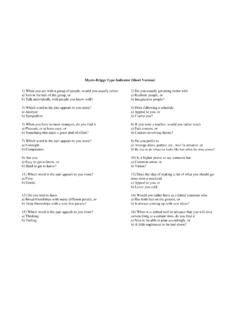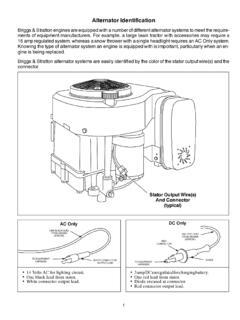Transcription of MYERS BRIGGS TYPE INDICATOR INTERPRETIVE REPORT
1 MYERS - BRIGGS TYPE INDICATOR | STEP I INTERPRETIVE REPORTM yers- BRIGGS Type INDICATOR Step I INTERPRETIVE REPORT Copyright 1988, 1998, 2005, 2015 by Peter B. MYERS and Katharine D. MYERS . All rights reserved. MYERS - BRIGGS Type INDICATOR , MYERS - BRIGGS , MBTI, Step I, Introduction to Type, and the MBTI logo are trademarks or reg-istered trademarks of the MYERS & BRIGGS Foundation in the United States and other countries. The CPP logo is a trademark or registered trademark of CPP, Inc., in the United States and other , Inc. | | forJANE SAMPLEA pril 22, 2015 Interpreted byKevin ConsultantABC ConsultingINTERPRETIVE REPORT MYERS - BRIGGS TYPE INDICATOR | STEP I JANE SAMPLEENFP|2 About Your ReportYour MYERS - BRIGGS INTERPRETIVE REPORT is designed to help you understand your results on the MYERS - BRIGGS Type INDICATOR (MBTI ) assessment.
2 This assessment identifies which of 16 different personality types best describes you. Your reported MYERS - BRIGGS personality type ENFP Your preferences Extraversion | Intuition | Feeling | PerceivingIMAGINATIVE MOTIVATORThe MBTI assessment was developed by Isabel BRIGGS MYERS and her mother, Katharine Cook BRIGGS , who spent years observing people. They created the assessment based on the personality type theory proposed by psychologist Carl Jung. Their goal was to help people understand how natural, healthy differences in the way people take in information and come to conclusions lead so clearly to the different ways people act and react, make life choices, relate to others, and make sense of the world. These insights help explain why different people are interested in different things, prefer various kinds of work, and sometimes find it hard to understand each other.
3 The MBTI assessment is now used by organizations and individuals around the world to improve their interactions and to promote effectiveness in their work and personal lives. Organizations use it to improve communication, teamwork, and leadership. Those entering the work world use it to choose careers likely to match their interests and strengths; those seeking a change use it to target new career directions. Educators and students use it to make learning more interesting and compatible with individual learning and teaching styles. People in relationships of all kinds use it to better understand one another, improve communication, and reduce conflict, resulting in more positive and productive BRIGGS MYERS created descriptions of the 16 personality types , including the description presented for you in this REPORT .
4 Your type description will help you see your type s distinctive characteristics and how your type differs from others. The insights gained will help you better understand and appreciate the basic differences between people and more successfully manage the impact of those REPORT MYERS - BRIGGS TYPE INDICATOR | STEP I JANE SAMPLEENFP|3 Although each of us can and does use all of the preferences at least some of the time, people typically find one in each pair more comfortable and natural than its opposite. Think of your choices as something like being right- or left-handed. Both hands are valuable and useful, but most people use the hand they favor naturally more often and become more adept with it. In the same way, your type preferences are choices between equally valuable and useful qualities.
5 Your ENFP results are described MYERS - BRIGGS Personality Type: ENFPThe questions on the MBTI assessment are designed so that when you respond to a question, you show which preference in one of the four pairs of opposites you ways to direct and receive energySENSINGorINTUITIONO pposite ways to take in informationTHINKINGorFEELINGO pposite ways to decide and come to conclusionsJUDGINGorPERCEIVINGO pposite ways to approach the outside worldTHE WAY YOU DIRECT AND RECEIVE ENERGYE xtraversionPeople who prefer Extraversion tend to direct their energy toward the outside world and get energized by interacting with people and taking who prefer Introversion tend to direct their energy toward their inner world and get energized by reflecting on their ideas and WAY YOU TAKE IN INFORMATIONS ensingPeople who prefer Sensing tend to take in information that is real and tangible.
6 They focus mainly on what they perceive using the five who prefer Intuition tend to take in information by seeing the big picture. They focus mainly on the patterns and interrelationships they WAY YOU DECIDE AND COME TO CONCLUSIONST hinkingPeople who prefer Thinking typically base their decisions and conclusions on logic, with accuracy and objective truth the primary who prefer Feeling typically base their decisions and conclusions on personal and social values, with understanding and harmony the primary WAY YOU APPROACH THE OUTSIDE WORLDJ udgingPeople who prefer Judging typically come to conclusions quickly and want to move on, and take an organized, planned approach to the who prefer Perceiving typically look for more information before coming to conclusions and take a spontaneous.
7 Flexible approach to the REPORT MYERS - BRIGGS TYPE INDICATOR | STEP I JANE SAMPLEENFP|4 IMAGINATIVE MOTIVATORYour Type Description: ENFPENFPs see life as a creative adventure full of exciting possibilities. Unusually perceptive about people and the world, they are insightful about the present and future. ENFPs experience a wide range of feelings and intense emotions. They need affirmation from others and readily give appreciation and are innovators, initiating projects and directing lots of energy into getting them going. They are stimulated by new people, ideas, and experiences. They readily find meaning and significance in things and see connections that others don t. They are likely to be curious, creative, imaginative, energetic, enthusiastic, and value harmony and goodwill. They like to please others and will adapt to other people s needs and wishes when possible.
8 ENFPs tend to make decisions by applying their personal values while keeping others needs in mind. They are likely to be warm, friendly, caring, cooperative, and supportive. They have exceptional insight into possibilities in others and have the energy to help bring them to are usually lively, gregarious, and sociable, with a large circle of friends. They are interested in almost everything and have a zest for life that draws others to them. At the same time, they value depth and authenticity in their close relationships and will go to great lengths to create and support open and honest communication. ENFPs hate routine, schedules, and structure and usually manage to avoid them. They are normally verbally fluent, even in extemporaneous situations; however, when talking about their deepest values, they may suddenly become awkward and express their opinions with uncharacteristic intensity.
9 Others usually see ENFPs as personable, perceptive, persuasive, enthusiastic, spontaneous, and versatile. Sometimes life circumstances have not supported ENFPs in the development and expression of their Intuition and Feeling preferences. If they have not developed their Intuition, ENFPs may fail to take in enough information, mistrust their own insights, be uncertain, and accept others perceptions too quickly. If they have not developed their Feeling, they may go from enthusiasm to enthusiasm, never committing themselves, or they may make overly personal is full of possibilitiesEnthusiastic, warm, imaginativeMake quick, confident connections between events and information and proceed accordinglyWant frequent affirmation, readily appreciate and support othersSpontaneous, flexible, verbally fluent, often rely on their ability to improvise INTERPRETIVE REPORT MYERS - BRIGGS TYPE INDICATOR | STEP I JANE SAMPLEENFP|5 Your Unique Personality Type: ENFP The two middle letters of your MYERS - BRIGGS personality type show the two mental processes that make your type two middle letters are N (Intuition) and F (Feeling).
10 As an ENFP, you devote most of your energy to Intuition and support your Intuition with Feeling. Thinking (T) is not as appealing for your type and therefore is much less likely to be used. Least preferred and most rarely used of all is Sensing (S). ENFPs tend to develop Intuition and Feeling during the first half of life, and at midlife they begin to find Thinking and Sensing more interesting and easier to letters of your type also show what others are most likely to notice about you what you use in the outside world versus what you reserve for your inner world of ideas and impressions. Here s how that works for use your favorite process, Intuition, mostly in the outer world of people, things, and activities; this is what people can easily see when they observe you in action. You use your second process, Feeling, mostly in your inner world of thoughts and ideas, where others are unlikely to see it.




